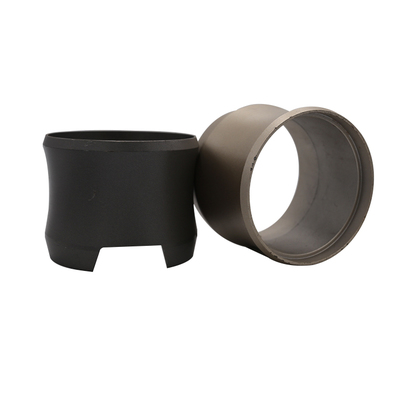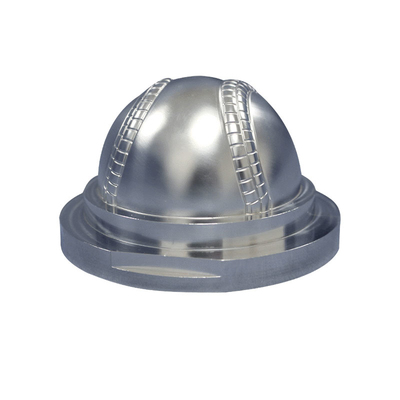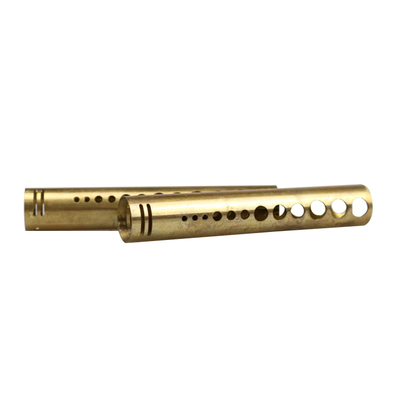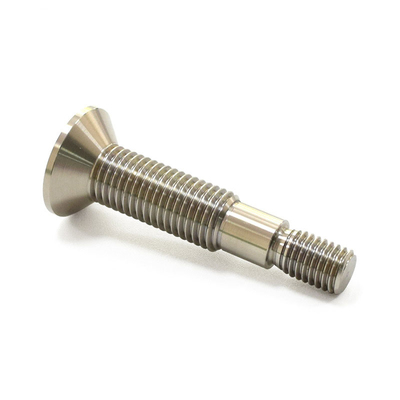Titanium alloy TC11 Precision Cutting Process
Titanium alloy TC11 Precision Cutting Process
|
Titanium alloy has the characteristics of low density, high strength, and higher specific strength than ultra-high strength steel; and good thermal stability, corrosion resistance, high temperature strength; at the temperature of 300 ~ 500 ℃, its strength is about 10 times higher than aluminum alloy, etc. , Has been widely used in aerospace, aviation and missile engine products. In particular, (α + β) titanium alloy can be quenched and aged to strengthen the alloy, and the strength after heat treatment is improved by 50% to 100% compared to the annealing condition. And it has outstanding low temperature resistance and outstanding resistance to seawater corrosion and hot salt stress corrosion, and it is more widely used. |
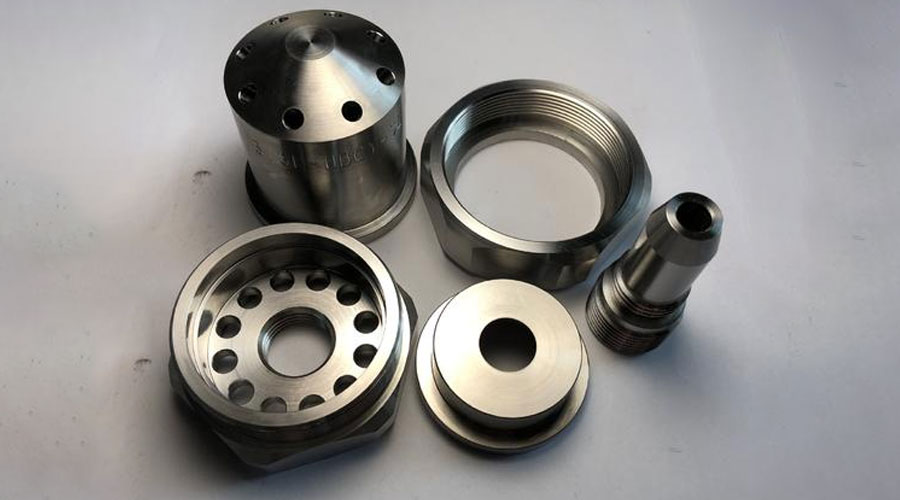
However, because the titanium alloy has a small cutting deformation coefficient (the deformation coefficient is less than or close to 1), the cutting process of the chip on the rake face increases the path of sliding conflict, which accelerates the tool wear; meanwhile, the cutting temperature is high, the cutting force is large, and The appearance of the degenerated pollution layer occurs because titanium machining has a large chemical activity and is liable to have a fierce chemical reaction with various gas impurities, such as O, N, H, C, etc., which invades the cutting surface layer of titanium alloy, causing the hardness and brittleness of the surface layer to increase. Others still have the composition of TCI and TiN hard surface layer; at high temperature, the surface layer is arranged with α-layer and hydrogen embrittlement layer and other externally transformed pollution layers. Formation of uneven surface layers, partial stress concentration, reduced fatigue strength of parts, severe damage to the cutting process, and appearance of chipping, chipping, and shedding; large affinity. During cutting, titanium chips and cut surfaces It is easy to bite with the tool data, and a severe sticking knife appearance occurs, leading to severe bonding wear; and the shortcomings such as the instability of the titanium alloy arrangement bring many difficulties to cutting, especially fine cutting, so it is also called awkward machining metal. Therefore, the technical discussion of titanium alloy fine cutting machining is a question that needs to be dealt with urgently.
The tail pipe housing (as shown in Figure 1) is a key functional part in a product in the author's factory. Because it is necessary to accept high temperature and pressure in the operating conditions, its mechanical function requirements are tensile strength Rm ≥ 1030MPa, elongation A ≥9, in order to satisfy its functional requirements, titanium alloy TC11 is used in the product planning, which is a typical thin-walled shaft tubular part. After the optimization planning of its fine cutting technology, the fine cutting of titanium alloy TC11 was completed.
1.Titanium Alloy TC11 Cutting Features
TC11 titanium alloy is a (α + β) type Ti alloy. Its arrangement is composed of densely packed hexagonal α phase and body-centered cubic β phase. Compared with other metals, the texture is more significant and the anisotropy is stronger, which brings greater difficulties to the production and machining of titanium alloys. . Its cutting process features are as follows:
- (1) High cutting force and high cutting temperature. Because titanium alloy has low density and high strength, the cutting feed has large shear stress and large plastic deformation work, so the cutting force is high and the cutting temperature is high.
- (2) Severe work hardening. In addition to plastic deformation, titanium alloys work hardly because of the inhalation of oxygen and nitrogen at high cutting temperatures, the occurrence of solid solution in the voids, and the conflicting effects of high hardness particles on the tool.
- (3) Simple stick knife. Titanium alloys have strong chemical affinity at high temperatures, coupled with large cutting forces, further promotes tool wear and tear.
- (4) Tool wear is severe. Divide wear is a significant feature of tool wear when cutting titanium alloys.
2.Workpiece Analysis
3.Technical solution
3.1 Technology Road
Technical road is based on the principle of "thickness first, then finishing, inside and then outside" to reduce deformation during finishing and improve machining accuracy. In the early trial production process, the technical roads are: blanking, car length, rough turning shape, drilling, rough boring, precision turning shape, finishing shape.
Titanium alloy has poor thermal conductivity, low density and specific heat, and high cutting temperature; it has a strong chemical affinity with the tool, and it is simple to stick the knife, making cutting difficult. Experiments have confirmed that the greater the strength of a titanium alloy, the worse its machinability. Therefore, it is necessary to choose tungsten-cobalt-based hard alloys with low chemical affinity, good thermal conductivity and high strength in the machining process.
The roughing car is YG8, the semi-finishing car is YG6, and the finishing car is YG3X. The drill is made of cemented carbide twist drill (YG6 cemented carbide).
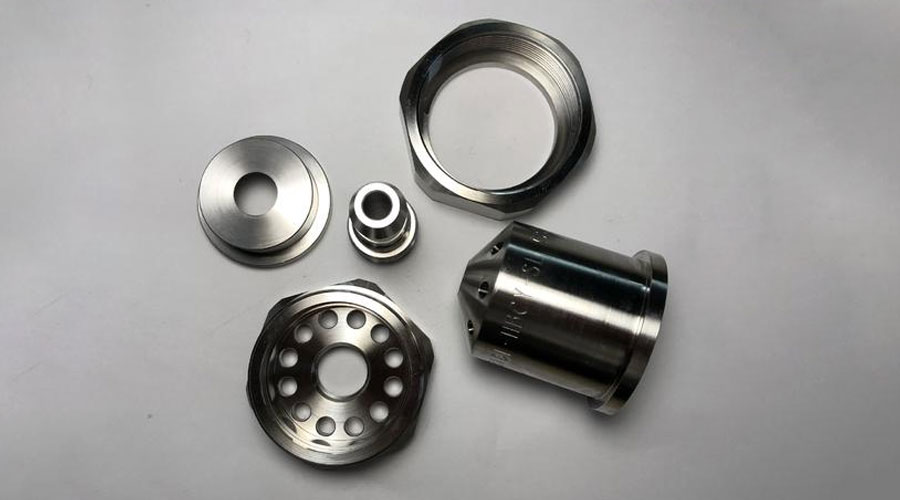
3.2 In doubt
- (1) When a hard alloy twist drill is used for drilling, the cutting temperature is appropriately high, the drill bit is severely worn, and the thermal stress of the machining process is directly affected, which directly affects the accuracy of subsequent finishing.
- (2) The workpiece has large deformation, and the machining size is difficult to control.
- (3) The condition of out-of-coaxiality is severe, the qualified rate of the workpiece is low, and the uniform qualified rate is only 50%.
- (4) The production power is not high, the tool wear is large, and the production cost is large.
3.3 Treatment plan
3.3.1 Pick the right tool from scratch
After studying the data and machining process, it was decided to use Kenner HTS-C machine-type drill bit (jet suction drill) for drilling; this bit can provide powerful cooling and is equipped with indexable PVD coating overall hard alloy Inserts and chip flutes and carbide drills. After experiments, the drill uses KC720 and KC7215 inserts (front and back inserts) that specialize in difficult-to-machine materials to drill titanium alloys. The output power is increased by 60%, and the workpiece after drilling does not generate heat and deformation. There is no stress effect during machining, and there is no pollution to the surrounding environment, as shown in Figure 2.
3.3.2 Analysis of deformation causes and countermeasures
The main reason for the deformation in the machining process is because the titanium alloy arranges the stress. In the early stage of the trial production process, although the technology adopted the machining technology of roughing first, then finishing, and then inside and outside, but did not fully consider the unstable elements of titanium alloy arrangement, forming the appearance of workpiece deformation and difficult to control the size during machining. How to reduce the deformation control of the titanium alloy machining process to the minimum is a difficult problem.
After repeated experiments, we add an aging annealing process after the rough machining of the workpiece. Without reducing the mechanical function of the workpiece, the grains are refined, and then the fine arrangement is reached to eliminate the internal stress and make the arrangement reach a stable state.
The heat treatment standard is as follows: the aging temperature is 530 ℃, and the holding time is 4 ~ 6h. Ensure that Rm≥1030MPa and A≥9%. After several batches of experiments, the tensile strength Rm is higher than 1030 MPa, and the elongation A is more than 9%.
3.3.3 Reasons for Out-of-Coaxiality and Countermeasures
Aiming at the low qualification rate of the workpiece caused by the poor coaxiality, further analysis of the workpiece data and machining technology found that the workpiece is a thin-walled tube, which is a typical deformable and difficult-to-machine metal. As long as the rigidity of all technical systems is improved, Talent to effectively handle its machining questions.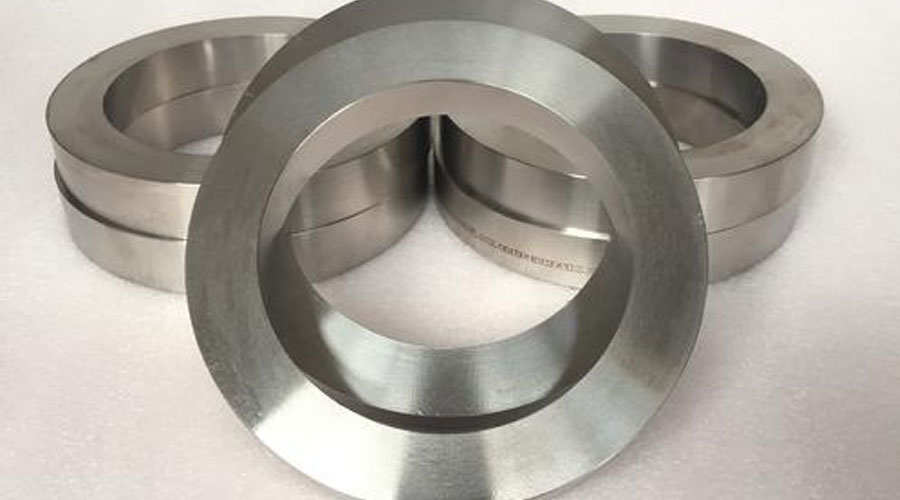
- (1) During internal hole machining, the technical step method was reasonably set. The technical step with a certain rigidity was used as the clamping and positioning reference of the workpiece, which effectively dealt with the problem of deformation of the internal hole during machining, as shown in Figure 3.
- (2) In the process of outer circle machining, a mechanical method of filling anti-vibration material is adopted, that is, during the semi-finished turning process of the workpiece, the clamping part is filled with a rigid pad to prevent the deformation of the workpiece; the inner hole of the workpiece is filled with soft The flexible rubber tube or foam material makes it fit into its inner wall during the machining process, and then reaches the effect of adding rigidity to the workpiece, as shown in Figure 4.
- (3) In order to ensure the coaxiality of the workpiece, a set of over-positioning fixtures was planned during the final finishing process to improve the rigidity of the workpiece, as shown in Figure 5.
Then, the coaxiality of the workpiece is poor. Therefore, in the planning of the fixture, in order to ensure the rigidity of the workpiece, an over-positioning device was used. Not only did all the internal holes of the workpiece be used as the positioning reference, although the positioning appearance has occurred in theory, but in practice, it fully satisfied the needs of the workpiece. . See Figure 6.
Based on the above-mentioned characteristics of the TC11 titanium alloy during the cutting process and the mechanism that the alloy is difficult to cut, and related to the machining methods and experience of difficult-to-machine data in production practice, the cutting machining technology road was drafted from the beginning as follows: cutting-flat end- —Drilling—Inside and outside of rough car—Examination of aging and mechanical functions—Car benchmark—Inner hole of semi-finished car, Big hole of semi-finished car—Inner shape of finished car—Semi-finished car shape ——General Manager Ping, small end of fine car——Fine car shape.
The tail pipe housing of titanium alloy parts processed by this technical method fully meets the planning requirements, and the qualified rate of parts reaches more than 98%. The problem of fine cutting deformation of titanium alloy is effectively dealt with.
4.Conclusion
Titanium alloy has poor machinability, so how to improve and improve its machinability is a difficult problem. This article analyzes the cutting technical methods of the tail pipe shell of titanium alloy parts, completes the fine cutting of titanium alloy parts, and effectively handles the machining difficulties such as turning deformation and tool wear of titanium alloy TC11 thin-wall cylindrical parts. With further knowledge and understanding of the machining technology of thin-walled titanium alloy parts, it has accumulated a certain experience for the future machining of titanium alloy parts.
Link to this article: Titanium alloy TC11 Precision Cutting Process
Reprint Statement: If there are no special instructions, all articles on this site are original. Please indicate the source for reprinting:https://www.cncmachiningptj.com/,thanks!
 PTJ® provides a full range of Custom Precision cnc machining china services.ISO 9001:2015 &AS-9100 certified. 3, 4 and 5-axis rapid precision CNC machining services including milling, turning to customer specifications,Capable of metal & plastic machined parts with +/-0.005 mm tolerance.Secondary services include CNC and conventional grinding, drilling,die casting,sheet metal and stamping.Providing prototypes, full production runs, technical support and full inspection.Serves the automotive, aerospace, mold&fixture,led lighting,medical,bicycle, and consumer electronics industries. On-time delivery.Tell us a little about your project’s budget and expected delivery time. We will strategize with you to provide the most cost-effective services to help you reach your target,Welcome to Contact us ( [email protected] ) directly for your new project.
PTJ® provides a full range of Custom Precision cnc machining china services.ISO 9001:2015 &AS-9100 certified. 3, 4 and 5-axis rapid precision CNC machining services including milling, turning to customer specifications,Capable of metal & plastic machined parts with +/-0.005 mm tolerance.Secondary services include CNC and conventional grinding, drilling,die casting,sheet metal and stamping.Providing prototypes, full production runs, technical support and full inspection.Serves the automotive, aerospace, mold&fixture,led lighting,medical,bicycle, and consumer electronics industries. On-time delivery.Tell us a little about your project’s budget and expected delivery time. We will strategize with you to provide the most cost-effective services to help you reach your target,Welcome to Contact us ( [email protected] ) directly for your new project.

- 5 Axis Machining
- Cnc Milling
- Cnc Turning
- Machining Industries
- Machining Process
- Surface Treatment
- Metal Machining
- Plastic Machining
- Powder Metallurgy Mold
- Die Casting
- Parts Gallery
- Auto Metal Parts
- Machinery Parts
- LED Heatsink
- Building Parts
- Mobile Parts
- Medical Parts
- Electronic Parts
- Tailored Machining
- Bicycle Parts
- Aluminum Machining
- Titanium Machining
- Stainless Steel Machining
- Copper Machining
- Brass Machining
- Super Alloy Machining
- Peek Machining
- UHMW Machining
- Unilate Machining
- PA6 Machining
- PPS Machining
- Teflon Machining
- Inconel Machining
- Tool Steel Machining
- More Material

